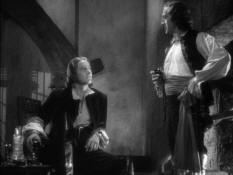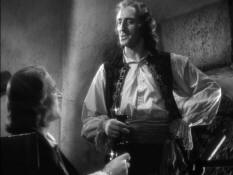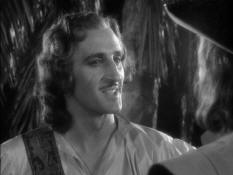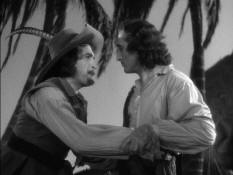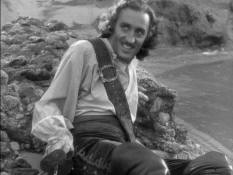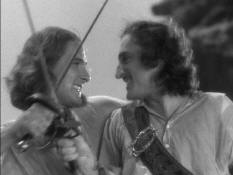Captain BloodPage Two "The definitive pirate movie is Captain Blood. ... The film held reasonably close to Sabatini's novel, which was based on [Sir Henry] Morgan's exploits within a fictional framework, recounting the story of an Irish surgeon falsely accused of being a Monmouth rebel and sold into slavery, falling for the niece of his brutal owner, escaping to become a buccaneer, turning patriot in a crisis, getting the girl, and becoming Governor of Jamaica." —George MacDonald Fraser, The Hollywood History of the World, 1988 "Rathbone's interpretation of the French pirate was a memorable one. As Levasseur, he was an able leader of men and smart enough to realize that an alliance with Blood would be to his benefit. ... Their duel-to-the-death on the desolate rocky beach remains the high point of the picture. ... the scene still contains excellent swordplay and is enthralling to watch. The shot of the waves washing over Rathbone's body is most effective." —Michael B. Druxman, Basil Rathbone: His Life and His Films, 1975 "Errol Flynn plays the part of Peter Blood—doctor, slave, pirate and lover—and does a good job for an actor who has that much thrust upon him. He is aided in his plundering by Basil Rathbone as Levasseur, a French pirate." —Springfield Evening Union, December 26, 1935
"Only yesterday Basil Rathbone was grinding the poor of Paris in A Tale of Two Cities, and now, with equal skill if slightly increased likableness, he is quarreling with Captain Blood over the disposition of the handsome English captive, Miss Arabella Bishop. Mr. Rathbone has a habit of dying violently in his pictures, but his demise in this one, when Blood punctures him at the conclusion of a desperately waged duel, seems more lamentable than usual. Perhaps it is because he lacks the proper seasoning of villainy this time." —Andre Sennwald, The New York Times, December 27, 1935 "Captain Blood is brilliant, hearty fiction and neither Mr. Flynn nor Mr. Curtiz ever let down, except perhaps for a few moments at the end when it lapses into low comedy. Olivia De Havilland is a beautiful if only moderately effective Arabella, and Basil Rathbone seldom suggests the bad man he's supposed to be." —Harold W. Cohen, Pittsburgh Post-Gazette, January 2, 1936 "From a big and excellent cast many players may be cited for work full of color: Lionel Atwill as the vicious Colonel Bishop; Basil Rathbone as the oily pirate Levasseur; Ross Alexander as the slave and prisoner Jeremy Pitt ... But especially outstanding is George Hassell's Governor Steed, fatuous, funny, likeable, a remarkable impersonation." —The Sacramento Union, January 26, 1936
"Basil Rathbone, as usual, makes an impression by his playing of the French pirate, Levasseur." —New York Daily News, December 26, 1935 "Olivia de Havilland, Lionel Atwill, Ross Alexander, Guy Kibbee, Basil Rathbone, to mention but a few, were outstanding, but each of the 29 major players well merits a salvo of applause." —Photoplay, March 1936 "There is a long list of performers in this noteworthy film. Lionel Atwill as the wicked Col. Bishop who enjoys flogging slaves and branding them; Basil Rathbone, who takes the role of roistering pirate, Capt. Levasseur; and Guy Kibbee, slave first and finally gunner for Capt. Blood—they play their roles with gusto and give portrayals that must have pleased themselves as well as they do the audience." —The Boston Globe, December 26, 1935 "Errol Flynn, English actor recently imported by Hollywood, is glamorous in the title role. His duel with a bloodthirsty French pirate, played capably by Basil Rathbone, is one of the most breath-taking sequences seen on the screen since the antics of Douglas Fairbanks." —The Patriot News (Harrisburg, PA), December 26, 1935
"Worthy of particular commendation is the fidelity to detail in recreating the period of King James. They have caught the feel and spirit of those hectic and troublous time, and the observer is transported into a world of romance, high adventure and reckless swashbuckling bravado long since gone. The battle scenes between the two French frigates and Captain Blood's buccaneer ship are splendid ... The picture moves with surging suspense and realism from one stirring episode to another, mounting to an altogether satisfactory climax." —The Film Daily, December 19, 1935 "Basil Rathbone as Levasseur is superb." —Kaspar Monahan, The Pittsburgh Press, January 2, 1936 "Captain Blood is not only possessed of a vigorous story with an important romantic strain but it is people with a cast meticulously chosen for type and ability, a cast that has such stalwarts as Basil Rathbone, David Torrence and Frank McGlynn playing small roles." —Wood Soanes, Oakland Tribune, Jan. 11, 1936
"Rathbone was a good club fencer who prided himself on his expertise—'a skilled swordsman,' as he described himself—and in The Adventures of Robin Hood (1938) he and Flynn crossed swords with a minimum of doubling. ... Cavens declared, "I doubt that [Rathbone] would do well in competition, but for picture purposes he is better than the best fencer in the world." —Richard Cohen, By the Sword, 2002 "Occasionally one runs across a Hollywood history describing the Captain Blood duel as between two actors ignorant of fencing, but this is arrant ignorant nonsense compounded by a lack of research: by all accounts, including eyewitness and other firsthand, Rathbone was a competent fencer, if not a competitor. There is no shame in being a club fencer; many of us who were once serious competitors tire of competition and become club fencers for reasons of recreation and study — for sheer pleasure, in other words." —Benerson Little, The Duel on the Beach Part IV: Flynn versus Rathbone in Captain Blood, March 29, 2022 "Though Basil Rathbone always felt miscast as Levasseur, he delivers as the perfect snobbish scoundrel. His fencing skills also need to be seen to be believed." —David Reddish, At 90, Captain Blood Still Delivers Pirate Thrills, CBR, January 25, 2025
"The handsome new leading man, Errol Flynn, dominates the picture throughout, but there is excellent support from Miss De Havilland, Lionel Atwill, and Basil Rathbone, a rival pirate, between whom and Flynn there is a sword duel that is more than a mere slapping of blades." —William J. Lewis, Pittsburgh Sun-Telegraph, January 2, 1936 "Olivia De Havilland as Arabella, Lionel Atwill as her uncle, and Basil Rathbone as the French pirate ... all give excellent accounts of themselves." —The Springfield Daily Republican, December 26, 1935 "The acting is, for the most part, robust, particularly in the parts played by Guy Kibbee, Robert Barratt, Ross Alexander, Lionel Atwill, and Basil Rathbone." —The Brooklyn Eagle, December 26, 1935
Back to Page One, review of Captain Blood Go to Page Three: Posters Lobby Cards and Promo Photos
|







